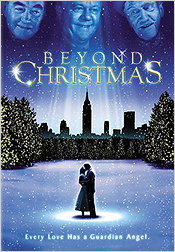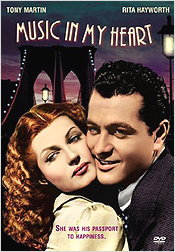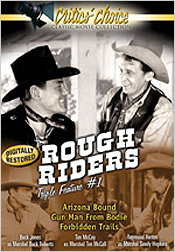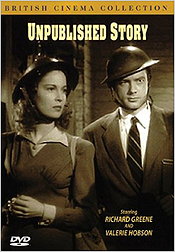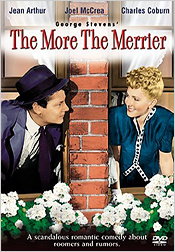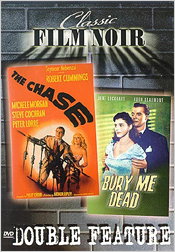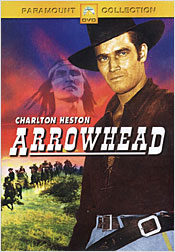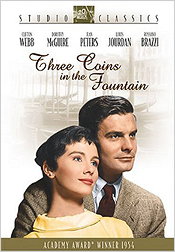 |
Site created 12/15/97.

page created: 1/10/05
 Back to Part One Barrie Maxwell - Main Page |
||
| Classic
Reviews Roundup #14 - January 2005 (continued) Beyond Christmas (1940) (released on DVD by Fox on October 12th, 2004) Good old Legend Films is back in action and this time they've applied their unpalatable colourization efforts to a 1940 RKO-distributed feature entitled Beyond Tomorrow. So pleased with their work that I guess they assume there's some value added by their efforts, Legend even has had the nerve to rename the film Beyond Christmas and via Fox, release it in mid-October to cash in on the season. True, the film does have a Christmas component to it, but its focus distances it from being a truly seasonal film. Back in 1940, it was a mid-year release and not particularly viewed as a Christmas item. |
||
| Fox's
DVD forces you to wade through the menu to its special features
section to find the black and white version of the film. The effort
isn't greatly rewarded. The correctly framed full screen version you
find is in fairly rough shape. The image is subject to some flicker
and is rather soft with only fair contrast and noticeable loss of
detail in darker scenes. Speckles and scratches are common. If you
insist on looking at the colourized version, it hides the debris
somewhat but you have to suffer through the usual pallid hues. The
film's mono sound has plenty of hiss and crackle. Special features
include several deleted scenes that are only available colourized
and trailers for two Legend Films efforts - this one and last year's
A Christmas Wish (a renaming
of The Great Rupert). Anyone
who's interested in Beyond Tomorrow
is further ahead to obtain VCI's release which treats the film with
respect by retaining its title and RKO logo, offering it only in
black and white, and providing a somewhat better looking transfer
than this Fox release. The film is in the public domain so there are
numerous other versions from the usual public domain suspects,
including a double feature disc from Marengo that also contains a
truncated version of the 1935 Scrooge.
It's not a bad value so long as you're aware of what you're getting. Music in My Heart (1940) (released on DVD by Columbia on September 7th, 2004) One of the things that Columbia is doing right with its catalog is its release of a goodly number of Rita Hayworth films. If my count is correct, we've already had an even dozen come out on DVD and there aren't too many of Rita's better Columbia films now unavailable. One of My Gal Sal or Tonight and Every Night or Miss Sadie Thompson would have seemed like a good next choice, but instead, Columbia has for some reason decided on Music in My Heart - a decidedly routine programmer from 1940. While it's good to see that the studios are willing to mine their catalogs for such lesser known items, there's a need to have people really knowledgable about classic films making the selections. Columbia has a lot more interesting items deep in its catalog than Music in My Heart and one fears that poor sales of such a selection may damn more worthy titles to permanent oblivion. A better Rita Hayworth film from her early Columbia programmer era would have been any one of Criminals of the Air, The Shadow, or The Lone Wolf Spy Hunt. |
||
| Belying
the film's quality is a very good DVD effort from Columbia. Using
source material obviously in pretty good shape, Columbia delivers a
sharp and lush-looking full frame transfer that exhibits a
finely-detailed gray scale. There is mild speckling and some grain
in evidence. Overall, a very film-like presentation. The mono sound
is also in very good condition. Martin's songs and Kostelanetz's
orchestrations sound somewhat richer than the music on a typical
transfer from this era. English and Japanese sub-titles are
provided. The only supplement is a set of three trailers for other
Rita Hayworth films. Rough Riders Triple Feature #1 (1941) Rough Riders Triple Feature #2 (1942) Rough Riders Triple Feature #3 (1942) (released on DVD by Falcon Picture Group for Critics Choice Video on November 9th, 2004) Cowboy trios were a popular component of the B westerns of the 1930s and 1940s. Republic's The Three Mesquiteers (initially Bob Livingston, Ray Corrigan, and Max Terhune) are probably the most well-known because of Republic's high B-western production values and the series longevity (51 films from 1936 to 1943). One of Republic's competitors - Monogram Pictures - thought so much of the idea that it had three such trios - The Range Busters, The Trail Blazers, and The Rough Riders. Of these, The Range Busters were the most long-lived (24 films from 1940 to 1943), but the best in my opinion were The Rough Riders. Three veteran B western stars - Buck Jones, Tim McCoy, and Raymond Hatton - played the leads and gave some real class to the films they made. All were 50 years of age or older, and appeared to really enjoy working with each other in the eight films they made together in 1941 and 1942. Jones, McCoy, and Hatton each played retired U.S. marshals who are summoned out of retirement at the beginning of each film to look after some injustice. At the end, each returns to his place of retirement (Jones to Arizona, McCoy to Wyoming, and Hatton to Texas) to the cry of "Goodbye Rough Riders". Due to the stars' ages, the action was sometimes rather perfunctorily handled, but the scripts were generally good and Monogram did its best to provide decent production values. After the U.S. entered World War II, Tim McCoy joined the service and without him, Buck Jones and Raymond Hatton did one more film playing their Rough Riders characters, but it (Dawn on the Great Divide) was not advertised as a Rough Riders film. It was Buck Jones' final screen appearance as he lost his life as a result of the Cocoanut Grove fire in Boston in November 1942. |
||
|
||
| All
eight Rough Rider films (Arizona Bound
[1941], Gunman from Bodie
[1941], Forbidden Trails
[1941], Below the Border
[1942], Ghost Town Law [1942],
Riders of the West [1942],
Down Texas Way [1942] and West
of the Law [1942]), plus Dawn
on the Great Divide, have been gathered together on three
discs by Falcon Picture Group for release by Critics Choice as part
of its Classic Movie Collection. Of the nine titles, all are quite
watchable if fairly formulaic of the B western genre. The most
interesting are Gunman from Bodie
and Ghost Town Law due to
somewhat more contrived plots than usual. Present in virtually all
of them are the extremely harmonious Rough Riders theme song ("The
Rough Riders ride, take care. The Rough Riders ride, beware …"),
the novel ways in which each of the three principals gets introduced
into each plot, and a fine cast of B western character players
featuring the likes of Charles King, Glenn Strange, Roy Barcroft,
Tris Coffin, Harry Woods, Bud Osborne, etc. If you're already
familiar with The Rough Riders films, you know the pleasure you're
in for as far as the films go. If you haven't seen the Rough Riders
before, look forward to films that are for the most part
entertaining timepassers indeed. Unfortunately, Falcon's presentation of the films on DVD leaves much to be desired. All are presented correctly full frame, but image quality is fair to poor. The transfers are a riot of scratches, speckles, dirt, and debris and look quite soft with poor contrast and poor shadow detail. Disc #1 is the least bad of the three with all three films looking better than the VHS copies with which I was able to compare them. Disc #2 is the worst. Unfortunately Ghost Town Law is on that disc and it's barely watchable. Riders of the West is out of focus and watchable only if you're prepared to put up with a headache afterwards. Disc #3 is modestly better than #2 so that at least Buck Jones's last film is watchable. The mono sound on all discs is in very rough shape with continuous hiss and crackle plus occasional motorboating. Most of the films seem complete although all their running times vary from those listed on the containers by at least a minute or two. The exceptions are Arizona Bound which is a shortened version of 49 minutes instead of the proper 58-minute length, and Dawn on the Great Divide which is its proper 70-minute length instead of the 62 minutes listed on the box. There are no supplements other than an unlisted trailer that precedes Forbidden Trails on disc #1. The trailer is for Silent Valley, a 1935 Reliable Pictures B western starring Tom Tyler. Unpublished Story (1942) (released on DVD by Shanachie on April 6th, 2004) The availability of British films made during the Second World War is very limited on Region 1 DVD, so it's nice to be able to report on the release of a little-known British title from 1942 entitled Unpublished Story. The DVD comes to us from Shanachie as part of its British Cinema Collection. |
||
| Part
of the film's value is the portrait of London that it offers during
the early war years just before and after the events at Dunkirk.
Actual as well as reconstructed London images of the city's bombing
and the aftermath give an immediacy and realism to the story that is
most appealing. The storyline is hardly novel, but it is told
briskly and acted with a sincerity and wit that makes the film's
91-minute running time pass quite quickly. Greene and Hobson play
off each other well and project a naturalness that's easy to like.
Basil Radford (one of the cricket fanatics in Hitchcock's The
Lady Vanishes) has a welcome supporting role as an
intelligence officer. The DVD's full frame image (in accord with the original aspect ratio) certainly represents no effort of restoration with its obvious speckles, scratches, and debris, not to some marked variations in sharpness. It is quite workable, however, with image detail that's not bad at all. The mono sound is adequate. No subtitles and no supplements are included. Recommended. The More the Merrier (1943) (released on DVD by Columbia on November 2nd, 2004) It's a pleasure to see Warner Bros. issuing several George Stevens films in December in honour of the 100th anniversary of his birth. Columbia makes its own contribution with the release of The More the Merrier, a 1943 screwball comedy that was Stevens' last film in Hollywood before joining the service during World War II. The story is inspired by the wartime accommodation shortage in Washington, D.C. and focuses on Connie Milligan (played by Jean Arthur), a young woman who patriotically decides to rent out one of the rooms in her apartment. It is taken up by retired millionaire Benjamin Dingle (Charles Coburn) whose motto is 'Damn the torpedos. Full speed ahead!". Connie is engaged to a rather stuffy bureaucrat named Charles Pendergast and Dingle decides that she can do much better. He secretly sublets half of his room to young Air Force sergeant Joe Carter (Joel McCrea) and proceeds to try to bring Joe and Connie together. |
||
| Columbia
has presented The More the Merrier
full frame in accord with the original aspect ratio. The film has
always looked somewhat beaten up on home video and unfortunately
that proves still to be the case on DVD. It may be remastered in
high definition, but there is no evidence of an effort to clean up
numerous scratches, missing frames, and moments of distortion.
Between the imperfections, there are decent stretches that are
fairly sharp and pleasing. The mono sound is in good shape, but the
disc offers no subtitles whatsoever. The supplements consist of
three trailers for unrelated films that are only accessible from the
menu as a package. For such a fine film, the DVD presentation is
almost as big a disappointment as Columbia's effort on The
Awful Truth. The Chase/Bury Me Dead (1946/1947) (released on DVD by VCI on August 31st, 2004) VCI has begun a series of film noir double feature releases. The first volume was a double bill of The Scar and The Limping Man, and now we have the second volume available combining The Chase, a 1946 United Artists release starring Robert Cummings, with Bury Me Dead, a 1947 Eagle-Lion release starring June Lockhart. |
||
|
||
| This
film has many key noir elements including a dreamlike atmosphere
that culminates in an ending that suggests the merging of dream and
reality, the typically expressionistic look, and the theme of the
disillusioned veteran. The usually bland Bob Cummings is
surprisingly effective as the rather seedy Scott while Steve Cochran
and Peter Lorre as Roman and Gino provide quintessentially cruel
portraits of noir antagonists. The only quibble I have is that
there's almost an embarrassment of noir riches to the extent that
one feels at times that the film is trying too hard to follow the
noir formula, thus distancing the viewer rather than immersing him
or her in the story. Still, the overall impact is positive and noir
aficionados will not be disappointed. That's not the case with Bury Me Dead, however. In fact, I wouldn't even classify this film as film noir. It's simply a low budget B film from Eagle-Lion that after a fairly interesting opening descends into a murky whodunit that's poorly acted on the whole and annoying combines witless humour with its plot resolution. The story concerns a woman who attends her own funeral and then enlists the aid of her lawyer to determine who wanted her dead and who's been buried in her place. June Lockhart offers a workmanlike effort as the woman and Hugh Beaument (later the father in Leave It to Beaver) is the lawyer. Cathy O'Donnell (who descended to poverty row rather quickly after her fine work in The Best Years of Our Lives) is one of the suspects. VCI's presentation of these films provides image quality that is quite workable, but far from the level of top-flight restorations. Both films (correctly framed in full screen) have some contrast problems, a fair amount of noticeable grain, and the usual dirt and debris. The Chase is the better looking of the two with decent black levels and acceptable shadow detail. Bury Me Dead offers a less consistent level of sharpness and poorer shadow detail. The mono sound on both is listenable, but accompanied by substantial hiss and crackle. There is no subtitling. VCI has provided a fair bit of added value in the disc's supplements, the most significant of which are audio commentaries by Jay Fenton who is apparently responsible for any restoration the films have received. His comments are interesting although delivered in a rather flat tone and somewhat repetitive of the written liner notes on an accompanying booklet inside the disc case. Other supplements include an abridged version of Bury Me Dead (entitled Death by Proxy) apparently created as part of a television contest giveaway, a poster gallery, trailers for several VCI noir releases, the 1942 Superman cartoon Showdown, and biographies for several key players. Recommended. Readers should note that The Chase is also available from Alpha, but in a much less desirable transfer than VCI's. Arrowhead (1953) (released on DVD by Paramount on November 9th, 2004) At a time when a more enlightened approach to portraying Indians in westerns was manifesting itself in such films as Broken Arrow and Devil's Doorway, Arrowhead was a throwback to the bad old days when the only good Indian was a dead one. Charlton Heston stars as cavalry scout Ed Bannon whose advice is disregarded when the cavalry reaches an apparent agreement with the Apaches that will see them resettled in Florida. The signal for the resettlement will be the return of the Apache Toriano from the east where he has been educated in the ways of the white man. Bannon, who was raised by the Apaches and knows their ways intimately, is unconvinced of Toriano's good intentions and bides his time, sure that his expertise will be required by the cavalry once more when Toriano's real plans become clear. |
||
| Arrowhead
was shot at 1.37:1 and Paramount presents it correctly full frame on
DVD. The Technicolor film looks very good with generally vibrant
colour and very good image detail. The disc does betray some
mis-registration of colours, presumably due to shrinkage of parts of
the three-strip negatives, but the occurrences are minor. The mono
sound is in great shape with virtually no age-related hiss or
distortion. English subtitles are also provided. There are no
supplements. Recommended for western fans. Three Coins in the Fountain (1954) (released on DVD by Fox on November 2nd, 2004) Three Coins in the Fountain was one of Fox's major releases for 1954, expansively mounted in CinemaScope with Technicolor and stereophonic sound. The story was adapted from the novel "Coins in the Fountain" by John Secondari (also the inspiration for 1964's The Pleasure Seekers, but set in Madrid) and tells about three American women who seek romance while working in Rome. Two of them (not three as suggested by the film title) throw coins into the Trevi Fountain for luck. Anita (Jean Peters) seems likely to match up with a handsome translator with questionable prospects (Rossano Brazzi); Maria (Maggie McNamara) pursues a prince known for his wolf-like behaviour (Louis Jourdan); and Miss Frances (Dorothy McGuire) has a seemingly fruitless crush on a self-centred writer (Clifton Webb). |
||
| The
costuming and set decoration are both beautifully done and the
film's colour cinematography (by Milton Krasner) is sumptuous.
Director Jean Negulesco, then one of Fox's major directors after a
number of years at Warner Bros., balances the three script threads
nicely and showcases all three of the female leads well. The result
is a film that plays much better than its title and plot synopsis
might suggest. Oh, and if you're wondering where that third coin in
the fountain comes in, it's understood that it was to have been
thrown into the fountain by one of the characters at the ending of
the film, but that scene was cut from the final version. Fox carried out an extensive restoration of Three Coins in the Fountain and the results are now available to us on DVD as part of Fox's Studio Classics line of releases. The 2.55:1 anamorphic transfer is excellent, reflecting Fox's restoration efforts and reasonably good source material from which to work. The image is very sharp for the most part and the colours are vibrant and true to life. There is some minor grain evident, but no edge effects, yielding a very film-like experience. The four-channel surround mainly comes across as a fine example of the directional stereo then in use and generally offers a fairly rich sonic experience for a film focused mainly on dialogue. Mono tracks in English, French, and Spanish are provided as are sub-titles in English and Spanish. The main supplement is an audio commentary by film historian Jeanine Basinger. She appears quite knowledgable about the film and goes into considerable detail on most members of the cast and crew although I would have liked to have heard more about the production pre-planning. Fox also provides a short restoration comparison, a Movietone newsreel on the Academy Awards which mentions the film's win for Best Song, a teaser, and two trailers (one shot flat and the other in CinemaScope). Recommended. |
On to Part Three
Barrie Maxwell - Main Page
 |
| Site
designed for 1024 x 768 resolution, using 16M colors and .gif 89a
animation. © 1997-2015 The Digital Bits, Inc., All Rights Reserved. billhunt@thedigitalbits.com |
